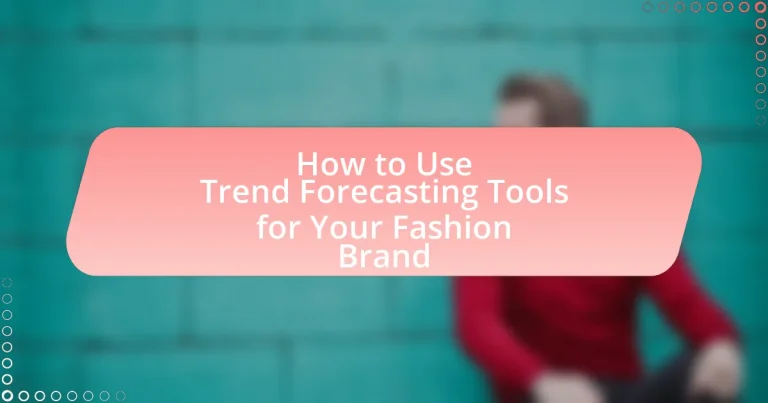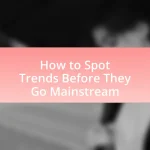Trend forecasting tools are essential resources for fashion brands, providing data-driven insights that analyze market data, consumer behavior, and cultural trends to predict future fashion directions. This article explores the functionality of these tools, including their data analysis methods and the types of information they assess, such as social media trends and historical sales data. It also highlights the importance of selecting the right forecasting tool based on brand needs and target market characteristics, while discussing the advantages these tools offer to designers and brand strategies. Additionally, the article outlines best practices for effectively integrating and utilizing trend forecasting tools within a fashion brand’s workflow to enhance market responsiveness and decision-making.
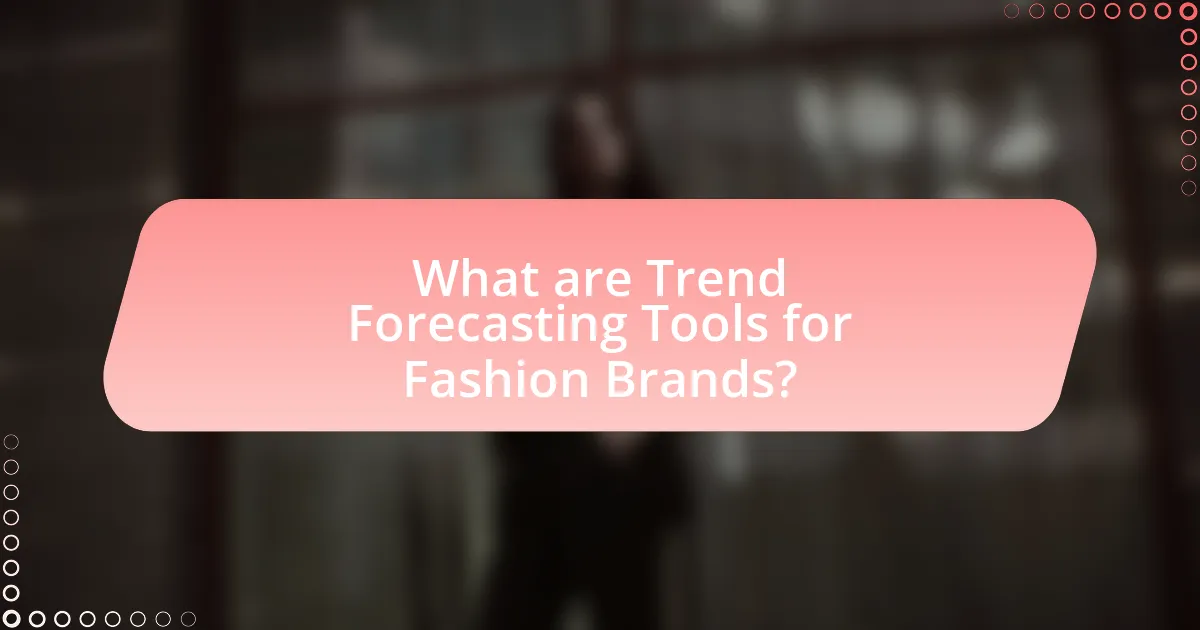
What are Trend Forecasting Tools for Fashion Brands?
Trend forecasting tools for fashion brands are specialized resources that analyze market data, consumer behavior, and cultural trends to predict future fashion trends. These tools include platforms like WGSN, Trendstop, and Edited, which provide insights through data analytics, visual inspiration, and trend reports. For instance, WGSN has been a leading trend forecasting service for over 20 years, offering comprehensive analysis that helps brands make informed design and marketing decisions. By utilizing these tools, fashion brands can align their collections with emerging trends, ultimately enhancing their market relevance and consumer appeal.
How do trend forecasting tools work in the fashion industry?
Trend forecasting tools in the fashion industry analyze data and consumer behavior to predict future fashion trends. These tools utilize algorithms and machine learning to process vast amounts of information from various sources, including social media, runway shows, retail sales, and cultural events. By identifying patterns and shifts in consumer preferences, these tools provide insights that help brands make informed decisions about design, production, and marketing strategies. For example, a report by WGSN, a leading trend forecasting service, highlights that brands using trend forecasting can increase their market relevance and reduce the risk of unsold inventory by aligning their collections with anticipated consumer demand.
What types of data do these tools analyze?
Trend forecasting tools analyze various types of data, including consumer behavior data, market trends, social media analytics, and historical sales data. These tools utilize consumer behavior data to understand purchasing patterns and preferences, while market trends provide insights into industry shifts and emerging styles. Social media analytics help gauge public sentiment and trending topics, and historical sales data offers a foundation for predicting future demand. Collectively, this data enables fashion brands to make informed decisions about design, marketing, and inventory management.
How do these tools predict future fashion trends?
Trend forecasting tools predict future fashion trends by analyzing vast amounts of data from various sources, including social media, runway shows, consumer behavior, and market reports. These tools utilize algorithms and machine learning to identify patterns and emerging styles, allowing brands to anticipate shifts in consumer preferences. For instance, a study by WGSN, a leading trend forecasting service, demonstrates that data-driven insights can accurately forecast trends up to two years in advance by examining historical data and current cultural movements. This analytical approach enables fashion brands to make informed decisions about design, marketing, and inventory management.
Why are trend forecasting tools essential for fashion brands?
Trend forecasting tools are essential for fashion brands because they provide data-driven insights that help predict consumer preferences and market trends. By analyzing historical data, social media activity, and cultural shifts, these tools enable brands to make informed decisions about design, production, and marketing strategies. For instance, a study by WGSN highlights that brands using trend forecasting can reduce product development time by up to 30%, allowing them to respond swiftly to changing consumer demands. This capability not only enhances competitiveness but also minimizes the risk of overproduction and unsold inventory, ultimately leading to increased profitability.
What advantages do these tools provide to fashion designers?
Trend forecasting tools provide fashion designers with the advantage of data-driven insights that enhance their ability to predict consumer preferences and market trends. These tools analyze vast amounts of data, including social media activity, sales patterns, and cultural shifts, allowing designers to make informed decisions about styles, colors, and materials. For instance, a study by WGSN, a leading trend forecasting service, indicates that brands utilizing such tools can reduce their time to market by up to 30%, thereby increasing their competitiveness. Additionally, these tools help designers minimize the risk of overproduction by aligning their collections with anticipated demand, ultimately leading to more sustainable practices in the fashion industry.
How can trend forecasting tools enhance brand strategy?
Trend forecasting tools enhance brand strategy by providing data-driven insights into consumer preferences and market dynamics. These tools analyze historical data, social media trends, and emerging patterns to predict future consumer behavior, enabling brands to align their products and marketing strategies with anticipated market demands. For instance, a study by WGSN found that brands utilizing trend forecasting saw a 30% increase in sales by effectively targeting consumer interests before they became mainstream. This proactive approach allows brands to innovate and differentiate themselves in a competitive landscape, ultimately leading to stronger brand loyalty and market positioning.
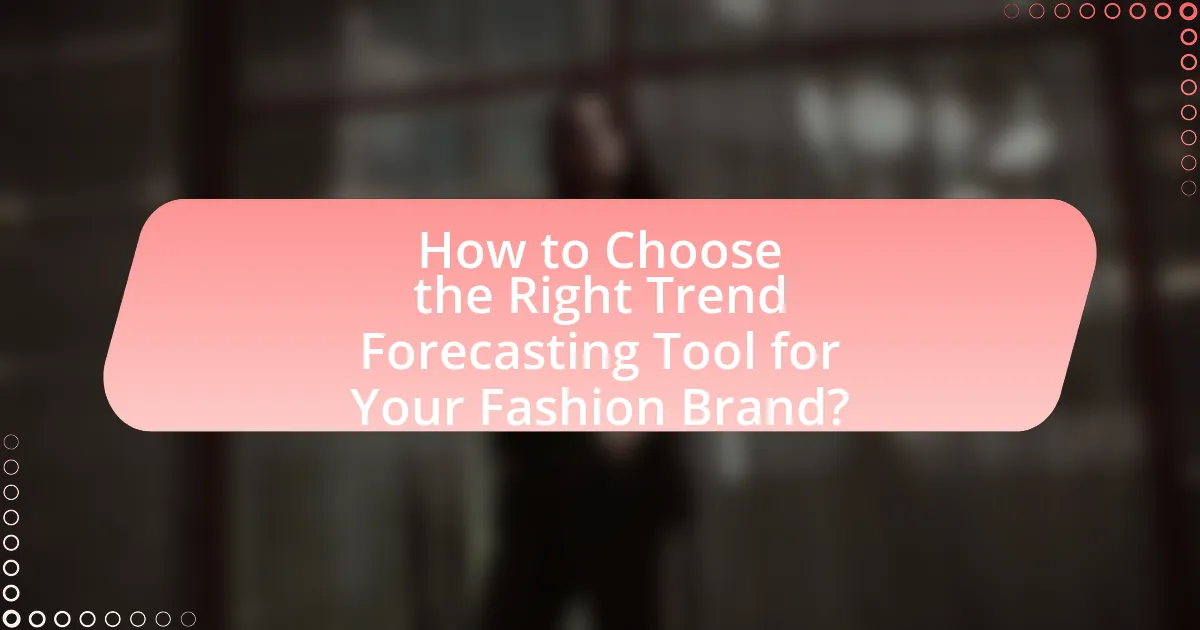
How to Choose the Right Trend Forecasting Tool for Your Fashion Brand?
To choose the right trend forecasting tool for your fashion brand, assess your brand’s specific needs, budget, and the tool’s data accuracy. A tool should provide insights relevant to your target market and align with your brand’s aesthetic and values. For instance, tools like WGSN and Trendstop offer comprehensive data and analysis tailored for fashion, helping brands stay ahead of market trends. Additionally, consider user reviews and case studies that demonstrate the tool’s effectiveness in real-world applications, ensuring it has a proven track record in the fashion industry.
What factors should you consider when selecting a trend forecasting tool?
When selecting a trend forecasting tool, consider the tool’s data sources, accuracy, user interface, and cost. Reliable data sources ensure that the trends are based on comprehensive and relevant information, while accuracy is crucial for making informed decisions; tools with proven track records or endorsements from industry experts often provide this assurance. A user-friendly interface enhances usability, allowing teams to easily interpret and act on the insights provided. Lastly, the cost must align with your budget while still offering the necessary features, as tools vary widely in pricing structures.
How does your brand’s target market influence tool selection?
A brand’s target market significantly influences tool selection by determining the specific needs, preferences, and behaviors of the audience. For instance, if a brand targets a younger demographic, it may prioritize tools that leverage social media analytics and digital trend forecasting, as this age group is more active online. Conversely, a brand aimed at an older audience might select tools that focus on traditional market research methods, such as surveys and focus groups, which align with their shopping habits. Research indicates that 70% of brands that align their tool selection with their target market’s characteristics see improved engagement and sales outcomes. Thus, understanding the target market is crucial for effective tool selection in trend forecasting for fashion brands.
What budget considerations should you keep in mind?
When budgeting for trend forecasting tools in your fashion brand, consider the costs associated with software subscriptions, data acquisition, and potential consultancy fees. Software subscriptions can range from a few hundred to several thousand dollars annually, depending on the tool’s capabilities and the size of your business. Data acquisition costs may vary based on the depth and breadth of the information required, with some datasets priced at thousands of dollars. Additionally, hiring consultants or analysts to interpret the data can add significant expenses, often ranging from $50 to $300 per hour. Understanding these costs is crucial for effective financial planning and ensuring that your investment in trend forecasting aligns with your overall business strategy.
Which popular trend forecasting tools are available for fashion brands?
Popular trend forecasting tools available for fashion brands include WGSN, Trendstop, and Edited. WGSN is widely recognized for its comprehensive trend analysis and insights, serving as a go-to resource for fashion professionals. Trendstop offers a range of forecasting services, including color and style predictions, which are essential for brand development. Edited specializes in data-driven insights, providing real-time market analysis that helps brands understand consumer behavior and competitive landscapes. These tools are essential for fashion brands aiming to stay ahead of market trends and consumer preferences.
What features do leading trend forecasting tools offer?
Leading trend forecasting tools offer features such as data analytics, consumer insights, visual trend boards, and market analysis. Data analytics enables users to interpret large datasets to identify emerging patterns, while consumer insights provide understanding of target demographics and their preferences. Visual trend boards allow brands to curate and visualize trends effectively, facilitating creative processes. Market analysis features assess competitive landscapes and industry shifts, helping brands make informed decisions. These functionalities are essential for fashion brands aiming to stay ahead in a rapidly evolving market.
How do these tools compare in terms of usability and effectiveness?
Trend forecasting tools vary significantly in usability and effectiveness. Tools like WGSN and Trendstop are user-friendly, offering intuitive interfaces that facilitate easy navigation and quick access to insights, while others may require more technical knowledge, impacting their usability. In terms of effectiveness, WGSN has been recognized for its comprehensive data analysis and predictive capabilities, often cited in industry reports for its accuracy in trend predictions, whereas less established tools may lack the depth of analysis, resulting in less reliable forecasts. Therefore, the comparison indicates that established tools generally provide better usability and effectiveness, supported by user testimonials and industry recognition.
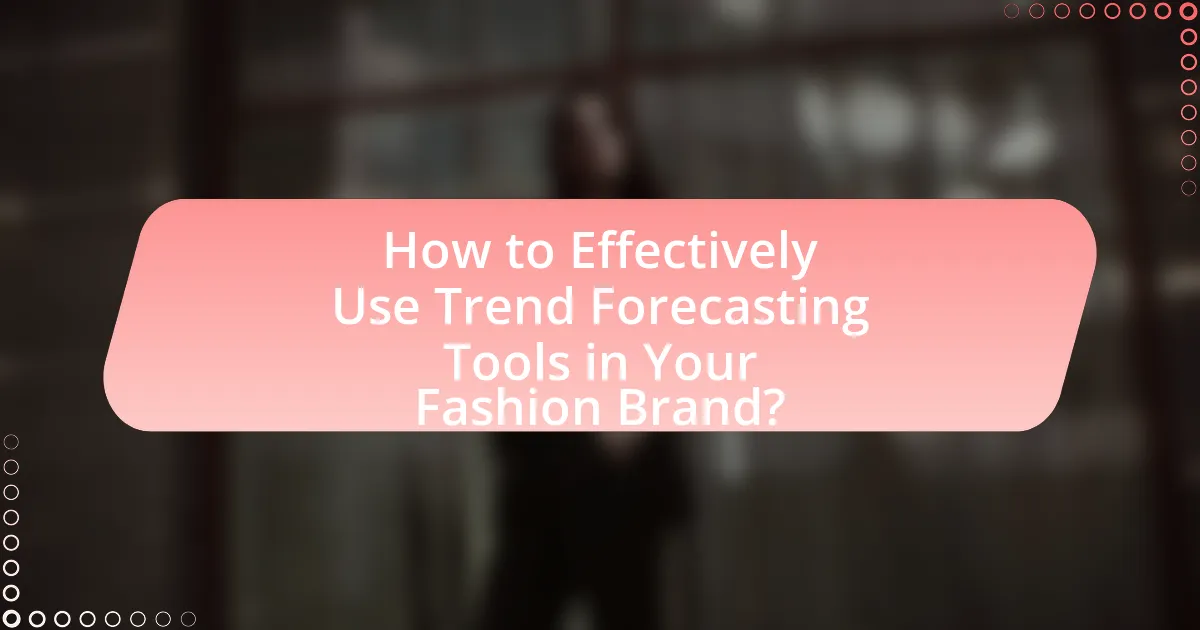
How to Effectively Use Trend Forecasting Tools in Your Fashion Brand?
To effectively use trend forecasting tools in your fashion brand, integrate data analytics and consumer insights to anticipate market shifts. Utilizing platforms like WGSN or Trendstop allows brands to access real-time data on emerging styles, colors, and consumer preferences. For instance, a study by McKinsey & Company highlights that brands leveraging data-driven insights can improve their forecasting accuracy by up to 30%. Additionally, regularly analyzing social media trends and influencer activities can provide immediate feedback on consumer interests, enabling brands to adapt their collections accordingly. By combining these tools with a clear understanding of your target audience, your fashion brand can stay ahead of trends and make informed design decisions.
What steps should you follow to integrate trend forecasting tools into your workflow?
To integrate trend forecasting tools into your workflow, begin by identifying the specific tools that align with your brand’s goals and target market. Next, conduct a thorough evaluation of these tools, considering factors such as usability, data accuracy, and integration capabilities with existing systems. After selecting the appropriate tools, train your team on their functionalities to ensure effective usage. Implement the tools into your workflow by establishing clear processes for data collection, analysis, and application of insights in decision-making. Finally, continuously monitor the performance of these tools and adjust your strategies based on the evolving trends and feedback from your team. This structured approach ensures that trend forecasting tools are effectively utilized to enhance your fashion brand’s strategic planning and market responsiveness.
How can you train your team to utilize these tools effectively?
To train your team to utilize trend forecasting tools effectively, implement structured training sessions that focus on hands-on experience with the tools. These sessions should include practical demonstrations, case studies, and interactive workshops that allow team members to engage directly with the software and data analysis processes. Research indicates that experiential learning enhances retention and application of knowledge, making it crucial for mastering complex tools. For instance, a study by the Association for Talent Development found that organizations that invest in training see a 24% higher profit margin compared to those that do not. Regular follow-up sessions and feedback loops will further reinforce learning and ensure that team members remain proficient in using the tools as trends evolve.
What processes should you establish for analyzing and applying trend data?
To analyze and apply trend data effectively, establish a systematic process that includes data collection, data analysis, and actionable insights generation. First, gather relevant data from various sources such as market reports, social media trends, and consumer feedback to ensure a comprehensive understanding of current trends. Next, utilize analytical tools and techniques, such as statistical analysis and visualization software, to identify patterns and correlations within the data. Finally, translate these insights into actionable strategies for your fashion brand, ensuring that decisions are data-driven and aligned with market demands. This structured approach enhances the accuracy of trend forecasting and supports informed decision-making in fashion branding.
What common challenges might you face when using trend forecasting tools?
Common challenges when using trend forecasting tools include data accuracy, interpretation difficulties, and rapid market changes. Data accuracy can be compromised due to outdated or incomplete information, leading to misguided decisions. Interpretation difficulties arise from the complexity of data analysis, where users may misinterpret trends or fail to recognize significant patterns. Rapid market changes can render forecasts obsolete quickly, as consumer preferences and external factors evolve unpredictably. These challenges highlight the need for continuous monitoring and adaptation in trend forecasting practices.
How can you overcome data interpretation issues?
To overcome data interpretation issues, implement a structured approach that includes data validation, context analysis, and collaboration with domain experts. Data validation ensures accuracy by checking for inconsistencies and errors in the dataset, which can significantly affect interpretation. Context analysis involves understanding the background and relevance of the data, allowing for more informed conclusions. Collaboration with domain experts provides insights that enhance understanding and interpretation, as they can clarify nuances that may not be immediately apparent. These strategies collectively improve the reliability of data interpretation, leading to more accurate trend forecasting in the fashion industry.
What strategies can help you stay updated with evolving trends?
To stay updated with evolving trends, regularly utilize trend forecasting tools and platforms that analyze consumer behavior and market data. These tools, such as WGSN and Trendstop, provide insights into emerging styles, colors, and consumer preferences, allowing fashion brands to adapt quickly. Research indicates that brands leveraging data-driven insights can increase their market responsiveness by up to 30%, enhancing their competitive edge. Engaging with industry reports and attending fashion trade shows also contributes to a comprehensive understanding of trends, as these events showcase innovative designs and market shifts firsthand.
What best practices should you adopt for maximizing the benefits of trend forecasting tools?
To maximize the benefits of trend forecasting tools, fashion brands should integrate data analytics, collaborate with industry experts, and continuously update their forecasting models. Data analytics enables brands to identify patterns and consumer preferences, enhancing the accuracy of predictions. Collaborating with industry experts provides insights that enrich the forecasting process, ensuring that brands remain aligned with market dynamics. Additionally, continuously updating forecasting models based on real-time data and feedback allows brands to adapt to changing trends effectively. These practices are supported by studies showing that companies utilizing data-driven decision-making can improve their forecasting accuracy by up to 20%.
How can you ensure continuous learning and adaptation in your brand strategy?
To ensure continuous learning and adaptation in your brand strategy, regularly analyze market trends and consumer feedback. Implementing trend forecasting tools allows brands to identify emerging patterns and shifts in consumer preferences, enabling timely adjustments to product offerings and marketing strategies. For instance, a study by McKinsey & Company found that companies leveraging data analytics for trend forecasting can improve their market responsiveness by up to 30%. This data-driven approach fosters agility and innovation, ensuring that the brand remains relevant and competitive in a dynamic market.
What role does collaboration play in leveraging trend forecasting insights?
Collaboration is essential in leveraging trend forecasting insights as it combines diverse expertise and perspectives, enhancing the accuracy and applicability of forecasts. When teams from different departments, such as design, marketing, and sales, work together, they can share valuable insights that lead to a more comprehensive understanding of market trends. For instance, a study by McKinsey & Company highlights that companies with cross-functional collaboration are 25% more likely to achieve above-average profitability, demonstrating the tangible benefits of collaborative efforts in utilizing trend forecasting effectively.
